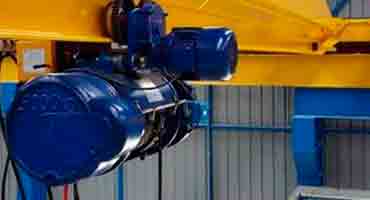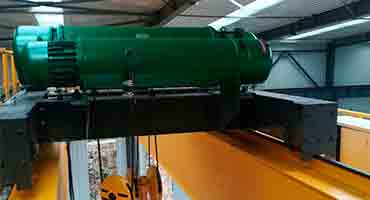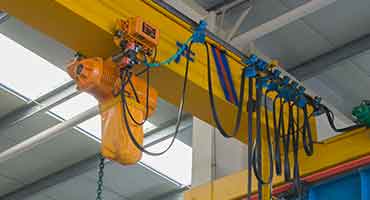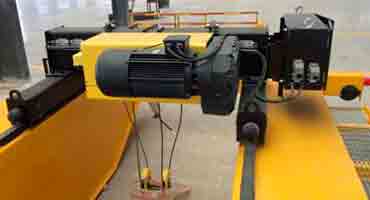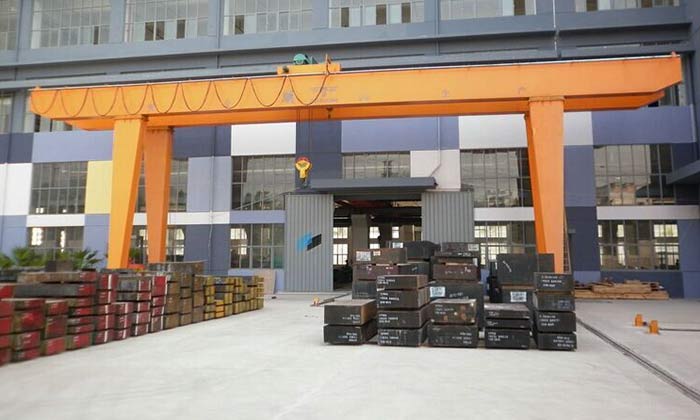
Gantry Crane Safety Requirements, Precaution of Use & Inspection
In today's manufacturing and construction industries, moving large, heavy loadis critical. Safe crane operationnot only including the right selection of gantry type and suitable crane specifications for the material handling taskbut also covering the crane inspection to ensure the safety and good working condition of gantry crane before each use.
General Requirements for Overhead Crane & Gantry Cranes
All industrial gantrycranes used in the workplace, including automatic, cab-operated, gantry, semi-gantry, wall, jib, bridge, and others, must meet the following requirements.
- On each side of the bridge or jib, thegantrycrane's rated load capacity should be clearly indicated.
- If the gantrycrane has more than one hoisting system, the rated load capacity should be indicated on each load block.
- If the gantrycrane has more than one hoisting system, the rated load capacity should be indicated on each load block. Hooks that don't have this information should be labeled "Do Not Use" and taken out of service until the load rating is determined.
- Do not use hoist hook that isfractured, strained, bend, or twisted. Each hook should include a safety latchthat closes the hook's throat automatically. The latch should be fixed before use if it is bent, has a broken spring, or is otherwise damaged.
- Permanently mounted, readable, and durable identification tags identifying size, grade, rated capacity, and reach should be attached to alloy chains and slings.
- The rated capacities for each type of hitch and synthetic web material should be marked or tagged on synthetic web slings.
- A multifunctional fire extinguisher should be installed on cab-operated cranes. Before being assigned to a position, operators should be instructed on how to utilize fire extinguishers.
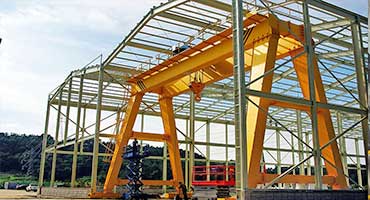
Double girder gantry hook crane
Double girder gantry crane specifications: Capacity: 5 ton - 500 ton, Span Length: 12~35m, Working Class: A5, A6.Ask for double girder gantry crane price.
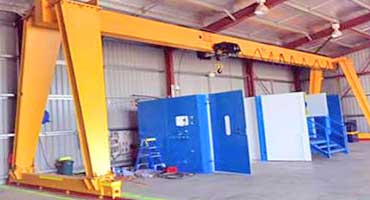
Single girder gantry hook crane
Single girder gantry crane specifications: Capacity: 1ton-20ton, Span Length: 8~30m, Working Class: A3, A4. Ask for single girder gantry crane price.
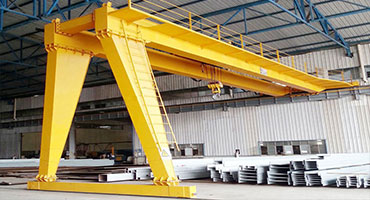
Single Leg semi gantry hook crane
Semi gantry crane designs, single leg gantry cranes, save half gantry crane cost with existing workshop.Semi gantry cranes & semi goliath cranes for sale.
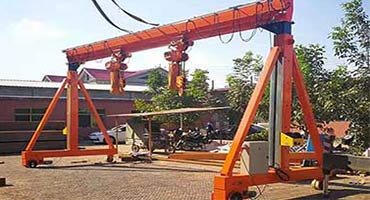
Portable gantry crane
250 kg - 10 ton portable gantry cranes & mobile gantry cranes with adjustable / fixed gantry for small & light material handling. Get portable gantry crane rolling now!
Precautions for the use of gantry cranes
Gantry cranes are typically located outside, where they are frequently exposed to wind, rain, and sunlight. Corrosion easily damages or deforms the major structure and components, and related electrical gantry cranecomponents and equipment are also prone to aging. This not only reduces the gantry crane's efficiency, but it also increases the risk of a workplace accident. As a result, appropriate employees must regularly maintain and maintain the gantry crane.
Lubrication of components
The lubrication of gantry cranes has a significant impact on their performance and longevity.Check the crane's hooks and wire ropes for broken wires, cracks, severe corrosion, and other issues, then clean and lubricate them.Second, every month, inspect the pulley block, reel, and pulley to see if there are any cracks and if the platen bolt and reel base bolt are tightened.
Motor and gearbox
Pay special attention to the motor during maintenance and maintenance of the door starter to prevent water or oil from entering during rotation, to ensure a waterproof connection between the motor and the junction box, and to ensure that the motor is used at a power supply higher than 85 percent of the rated voltage. It's worth noting that the gearbox frequently leaks oil. As a result, check that the seal is good when lubricating the gearbox, and that it is operated properly to avoid excessive oil and that the firmware is not tightened.
Gantry track/ railmaintenance
A small hammer tapping method is commonly used to examine the rails and rail fastening bolts for fractures and looseness when repairing the gantry crane track.
Forced part
The gantry crane's main force is concentrated and easily damaged, thus it should be thoroughly inspected. For example, the leg-to-main-beam connecting section, the angular bearing part of the bottom beam, the leg-to-beam connecting section, and so on. Furthermore, because the metal component is frequently exposed to the outsideenvironment, it must be corroded every year and repainted to effectively extend the metal structure's service life.
Auxiliary equipment
Because the gantry crane is a large-scale mechanical equipment that is used frequently, it is vital to verify the status of various limit devices during daily maintenance and maintenance to ensure that it is in excellent operating order while also preventing the gantrycrane from becoming blocked. The integrity of the board and the safety shield is an efficient way to protect the operator's personal safety; additionally, the Goliathcrane's different safety signal indications must be reliable. These auxiliary equipments are essential for ensuring regular operation and greatly assist in increasing the gantry crane's efficiency.
Daily Inspection Procedures for Overhead and Gantry Cranes
Gantry crane operations are safer when there is an active crane inspection program in place and maintenance is performed on a regular basis. The frequency of use is a vitalfactor in how often the gantrycrane should be inspected and serviced, but there are a few things that should be checked every day. Before using, OSHA mandates a visual check of the following items:
- Make sure the gantrycrane orhoist systemisn't marked as out-of-service.
- Double-check that all warning and safety labels are present and readable.
- Examine the rail mounted gantrycrane and the floor/ground beneath it for any signs of oil leaks.
- Examine hoisting and lowering, as well as trolley and bridge travel, for smoothness. Keep an ear out for anything out of the ordinary.
- Check the operation of the hoisting motion's primary limit switch.
- Before continuing travelling, make sure the trolley and crane brake systems are working properly.
- Visually inspect wire rope hoists for broken wires, broken strands, kinks, and other structural damage, such as "bird caging." Make sure the wire rope is properly reeved and that no rope pieces are twisted around one another.
- Check chain hoists visually for excessive wear, cracks, gouges, twists, kinks, or stretching beyond the manufacturer's specifications. Make that the chain is in both the top and lower sprockets, as well as the chain guide.
- Look for cracks, gouges, deformation of the throat hole, wear on the saddle or load bearing point, and twisting while inspecting hooks visually. To find out what tolerances are permitted, look at the owner's handbook.
- Look for damage to hook latches that prevents them from working properly.
- Inspect nylon or synthetic web slings for wear and tear as well as capacity. On the manufacturer's label, capacity ratings should be readable.
Monthly Inspection Procedures
OSHA also mandates a more complete crane inspection at periods ranging from one to twelve months. Itsuggests completing these inspections on a monthly basis as a best practice.
- Inspection Procedures for Intermittently Used Cranes
- Gantry cranes that aren't in use on on a regular basis, such as standby cranes, should be examined on a regular basis to guarantee safe functioning. The following is how OSHA categorizes inspection requirements:
- Before resuming service, a crane that has been idle for one month or more but less than six months should undergo an examination that includes all of the elements specified under "Daily Inspection Procedures." Furthermore, any rope that has been idle for a month or more owing to the shutdown or storage of the crane on which it is placed should be thoroughly inspected before being used.
- Before being put back into service, a gantrycrane that has been idle for more than 6 months should be given a thorough inspection in accordance with the elements stated under "Monthly Inspection Procedures." The craneinspection should be followed by the completion of the Crane Inspection Report.
Additional Safety Guidelines for Cranes
All gantry crane operators should be aware of the following general safety rules:
- Never load the crane over its rated capacity. Test the hoist brakes when lifting loads at or near capacity.
- Before lifting, position the hoist directly above the load's lifting point. Loads should be balanced and secured at all times. To ensure the load is balanced, do a preliminary lift of a few inches.
- Take things slowly. Avoid accelerating or decelerating suddenly.
- Before lifting a cargo, remove any slack from the sling, chain, or cable.
- Loads should never be suspended over people on the ground.
- At no time should anyone be allowed to ride on the hook or load.
- When a load is suspended, never leave the controls alone.
- Recognize where the crane/hoist disconnect switch is located. Place controls in the OFF position if electrical power is lost to avoid an unexpected start-up.
- Turn off the power to any hoist that appears to be hazardous or in need of repair.
